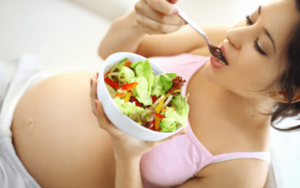
Current evidence suggests women should be supported in eating and drinking in labour if this is what they choose to do. Despite what the research says some hospitals and health care professionals enforce a policy that restricts women eating in labour. Conversely most hospital policies and health care professionals encourage women to drink during labour.
Food and fluid restrictions during labour came into place in the 1940’s when it was discovered that a leading reason for maternal death was due to aspiration of low pH gastric particles into the lungs when a woman was put under general anaesthetic. Gastric particles with a pH lower than 2.5 becomes hydrochloric acid and if aspirated (that is regurgitated and inhaled); it destroys sensitive tissue in the lungs which creates secondary pneumonia and can cause death. This phenomenon is called Mendelson’s Syndrome named after Dr Curtis Mendelson who discovered the low pH link.
What we must remember though is that the 1940’s was a very different time in maternity care.
Women experienced twilight sleep which was the administration of chloroform or ether to put women to sleep whilst their babies were extracted vaginally with forceps. It was a practice that many women demanded to avoid the pain of childbirth. The demand for twilight sleep grew so rapidly that general anaesthesia was administered by unskilled doctors, not anaesthetists as we have today. Women also had caesareans under general anaesthetic which is fairly rare today with most caesareans being performed under spinal or epidural. Today, with advanced anaesthetic techniques that include specialised intubation techniques and medications to neutralise gastric acid, reduce nausea and vomiting and speed up gastric emptying, Mendelson’s syndrome is avoidable. Today if a woman aspirates while she undergoes a general anaesthetic the cause is almost always medical error.
Some women are more at risk than others of aspiration. Women at increased risk of aspiration include women who are morbidly obese, who smoke, who have diabetes and women who have airway difficulties. Despite these risks, no woman classed as low or high risk of aspiration has experienced Mendelson’s syndrome in Australia since the mid 1980’s, despite eating and drinking restrictions being lifted in most birth environments.
What are the recommendations for eating and drinking in labour?
There are no governing guidelines in Australia and the advice from international authorities is conflicting. According to the Cochrane review (gold standard in maternity research), women should be able to eat and drink to their own comfort level. Many women want to eat in early labour, high prolactin levels stimulate appetite but in advanced labour, oxytocin suppresses it. If a woman is hungry she should eat. They recommended having small low fat, low-residue meals. Low residue foods would include white bread, pasta, potato, white rice, banana, fruit juice without pulp, crackers, pretty much all the foods nutritionists tell you to keep away from. However, women should also be advised that eating in labour is associated with prolonged labour and women who have epidurals and eat may be more likely to vomit as labour pain invokes a natural appetite suppressant
Most women are thirsty in labour and should be able to drink to their comfort level. Staying hydrated is important as labour takes a lot of energy and if dehydration occurs then it is likely contractions will slow and become less efficient which may result in intravenous fluids and/or syntocinon to get contractions going again. Syntocinon administration can lead to complications including an increased risk of assisted birth or caesarean.
Ideal drinks in labour include water and/or isotonic drinks. Isotonic drinks contain electrolytes which are easily absorbed and digested and replace what women lose in sweat. Some sports drinks are isotonic, as is coconut water.
What does this mean for me?
Drinking during labour helps to avoid dehydration and may prevent your contractions slowing down and weakening. Take sips as you feel the need. Early labour is a good time to have a snack and you are no more at risk of vomiting than you would be without eating but you should be aware that eating may make labour a little longer and if you eat after having an epidural, you may be more inclined to vomit.
Written 30th August 2014
References
Gyte, G. 2007, ‘NCT Evidence Based Briefing – Eating and drinking in Labour’, New Digest, vol. 1, pp. 25-30.
Hunt, L. 2013, ‘Literature review: Eating and drinking in labour’, British Journal of Midwifery, vol. 21, no. 7, pp. 499-502.
King, R., Glover, P., Byrt, K. & Porter-Nocella, L. 2011, ‘Oral nutrition in labour: ‘Whose choice is it anyway?’ A review of the literature’, Midwifery, vol. 27, no. 5, pp. 674-86.
Maharaj, D. 2009, ‘Eating and drinking in labor: Should it be allowed?’, European Journal of Obstetrics & Gynecology and Reproductive Biology, vol. 146, no. 1, pp. 3-7.
Parsons, M., Bidewell, J. & Griffiths, R. 2007, ‘A comparative study of the effect of food consumption on labour and birth outcomes in Australia’, Midwifery, vol. 23, no. 2, pp. 131-8.
Singata, M., Tranmer, J. & Gyte , M.L. 2013, ‘Restricting oral fluid and food intake during labour’, Cochrane Database of Systematic Reviews, no. 8,
Page revised on 16th December 2021


Recent Comments